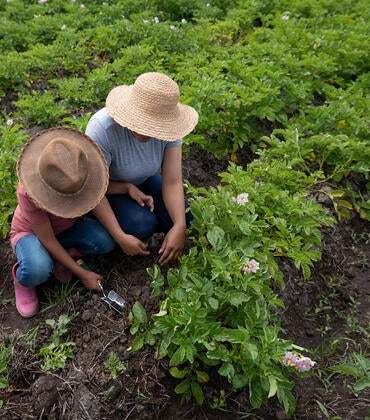
According to the Centers for Disease Control and Prevention, as of May 22, 2025, there have been 1,046 confirmed measles cases across 31 U.S. jurisdictions. Fourteen outbreaks have been reported, and 92% of cases (961) are linked to these outbreaks.
In a Q&A, three biomedical scientists at the University of California, Riverside, address the medical, social, ethical, and policy-related dimensions of measles. They explore the nature and impact of the disease, reasons behind its global resurgence, the effectiveness of prevention and treatment, and the responsibilities of individuals and governments in managing outbreaks. Their responses cover public health strategy, vaccine effectiveness, the role of misinformation, legal and ethical considerations around vaccination, and the heightened risks measles poses to vulnerable populations.
The experts, all of whom are faculty members in the Division of Biomedical Sciences in the School of Medicine, are Meera Nair, Scott Pegan, and Dr. David Lo.
Q: What is measles?
Nair: Measles, also known as rubeola, is a very contagious, life-threatening, respiratory illness caused by a virus. It is transmitted by infectious droplets or airborne spread when an infected person breathes, coughs or sneezes. Infection starts with fever, cough, runny nose, and red, watery eyes. Then, a rash of red spots breaks out, usually starting on the face and spreading down the body. Measles is so contagious that from one infected person, it is estimated that 9 out of 10 unvaccinated people close to that person will also get sick; this is an estimated nine times more infectious than COVID-19.
For those who get infected, especially unvaccinated children under five years of age or immunocompromised individuals, serious complications can develop including pneumonia and encephalitis (inflammation of the brain), which can be deadly. Unvaccinated pregnant women are also at risk for miscarriage and even death.
The good news is that measles is preventable; the measles vaccine, which is administered as part of the ‘MMR’ — measles, mumps, and rubella — vaccine to children at 12 months of age provides very effective and often lifelong protection after the second dose.
Q: How does measles impact the immune system?
Nair: Measles weakens the body’s immune system and eliminates immunological memory, often referred to as ‘immune amnesia.’ This means that after a measles infection, the body can lose some of its pre-existing immunity to other pathogens. This temporary but significant weakening of the immune system increases the risk of secondary infections for weeks or even months after the acute measles illness.
Q: What are the short- and long-term health risks associated with measles infection?
Pegan: Measles has some nasty short- and long-term health risks. In the short term, high fevers that spike beyond 104o accompanied by cough, watery eyes, white spots within the mouth, and the signature rash. Other complications can occur such as ear infections, diarrhea, and pneumonia. One in five individuals with measles typically gets hospitalized due to the severity of the infection. These statistics are playing out in real time within Texas and other states with infected populations.
The threat of measles regrettably doesn’t end with the initial illness, nor is it limited to the impact initial symptoms can have, such as hearing loss or brain damage. Individuals can also develop subacute sclerosing panencephalitis, also known as SSPE, seven to ten years post initial illness. Based on measles outbreaks in the early 90s within the U.S., SSPE may occur as often as 11 out of 100,000 cases. This degrative neurological condition has no specific treatment and is almost always fatal.
Q: How do measles outbreaks affect vulnerable populations, such as infants and immunocompromised individuals?
Pegan: Complications with measles is more prevalent in infants and young children as well as immunocompromised and those that are pregnant. Children and infants develop complications at a higher rate than adults, roughly 1 in 20 develop ear infections, diarrhea, and pneumonia. Pneumonia is the leading cause of death among children who contract measles. Also, the probability of contracting SSPE is considerably higher for children who contract measles before the age of two. Mortality rates for those who are immunocompromised can be in the high double digits depending on the cause of the immunocompromised condition.
Q: Measles has no cure. How is it treated?
Nair: Unfortunately, there is no specific antiviral medication that directly cures measles. Treatment focuses on supportive care to help relieve symptoms and prevent complications. This includes rest, drinking plenty of fluids, and using fever-reducing medication. The patient should also be monitored for complications such as secondary infections like pneumonia or encephalitis, which may require specific treatment with antibiotics or other interventions.
The World Health Organization recommends vitamin A for children with measles, as it can help reduce severe outcomes, especially in areas where vitamin deficiency is common.
Q: Why are cases rising around the world?
Nair: Unfortunately, despite it being a vaccine-preventable disease, the rise in measles cases globally and in the U.S. is most likely due to lower vaccination rates. This can happen when people aren't getting their shots due to misinformation about vaccine safety or disruptions in vaccination programs. When there are lower vaccination rates, we lose our ‘herd immunity,’ meaning that there can be outbreaks. Additionally, those individuals that are not able to get vaccinated because they are too young, are immunocompromised, or don’t have access to vaccines, are now at risk of measles when they would have otherwise been protected by herd immunity. In the U.S., there are currently ongoing outbreaks in some communities with low vaccination coverage. International travel also plays a role, as people can get measles in other countries and bring it back to their homelands.
Q: What role does vaccine misinformation play in the resurgence of measles?
Pegan: Misinformation around measles and vaccines in general have been on rise since the late 90s contributing to an erosion of vaccination rates. Misinformation feeds into several decision-making aspects of whether someone gets vaccinated. This may include misinformation downplaying the severity the disease, need of the vaccine, healthcare benefits of vaccines, or motives behind community vaccination efforts. Also, misinformation around the risks of vaccines versus negative health consequences of the disease is also common. This mistakenly leads individuals into thinking that by forgoing vaccination they might minimize any possibly of health risk by relying on others in the community to take on what they perceived are risks for them.
These social dynamics have led to substantial pockets within the U.S. of under vaccinated communities. While some counties have been able to keep their vaccination rates north of 95%, which is seen as the bar to stymie community spread of measles, many counties vaccination rates have fallen significantly below that number. For instance, several counties at the center of this year’s outbreak had historical kindergarten vaccination rates in the 80% range, if not lower. Riverside County’s MMR vaccination rate is hovering around 95%.
Q: Why does measles spread especially fast in an unvaccinated population?
Lo: The measles virus is particularly infectious. We describe the infectivity of a virus in terms of the number of people that can get infected from a single infectious patient, called R0 (“R naught”). It depends on several factors such as the survivability of the virus on surfaces, or its ability to spread by aerosols from coughing, or whether it can only be spread by fluids such as blood. While some viruses such as HIV have a relatively low R0 of about 2, polio is about 5, while measles is 16 or more, meaning it is extremely infectious. However, if the population is vaccinated above a certain level, such as 90 percent or more, then the virus is not able to spread because vaccinated individuals are resistant to the virus, and an epidemic stops with the one patient or only a few. The idea of letting people get “naturally” infected to build resistance instead of vaccinating is nonsensical because you are letting the virus spread and harm or kill susceptible people instead of trying to protect them. It is like saying let’s let the house burn down so it won’t catch fire again.
Q: How effective is the MMR vaccine in preventing outbreaks?
Lo: There are decades of rigorous research both during the initial development of the vaccine as well as follow up studies since then, all showing that MMR has been extremely effective. One notable study found that from 2000 to 2004 a now debunked claim about MMR and autism caused vaccination rates in England to drop below 80%. Measles cases, which had previously been almost nonexistent in the population, almost immediately spiked with thousands of new cases until vaccination rates got back up to normal levels, and measles went back down again.
Q: How can the trend of rising cases of measles be reversed?
Lo: The most straightforward approach is to get vaccination rates to 90% or above, so the virus spread is halted. Other more drastic approaches include quarantine of the affected population and blocking any travel to other communities. Over the centuries, government mandated quarantines have been used many times. The term came from the Black Death plague period when there was a mandated isolation of ships for 40 days to prevent spread of infection from the ship to the port city. Compared to modern vaccination strategies, that kind of society shut down has not always been so effective as we saw in China for the SARS-Cov-2 pandemic.
Q: How can public health officials respond effectively to contain a measles outbreak?
Pegan: With no approved drug to treat measles, public health officials’ best strategies are to provide vaccine education, lower other barriers to vaccination, and perform contact tracing.
A great example of vaccine education is by the Texas Department of State Health Services (DSHS), which has been reporting not only the number of cases, but also how many of those cases were among unvaccinated individuals versus individuals who received one or the full two doses. As of this week, DSHS is reporting vaccines prevent more then 97% of measles infections. Officials will need to continue and expand outreach efforts to encourage individuals to vaccinate. This may include what the state of Colorado is doing by sending parents reminders to vaccinate their children who may be overdue for vaccination. Vaccine access plans will also need to play a part in the response, working hand in hand with public outreach efforts to make sure those who need vaccination can readily obtain it.
Beyond educational and access efforts, contact tracing should continue to play a part in the response. While measles is one of the most infectious pathogens that stay in the air of a room for a couple of hours, identifying those infected can still slow community transmission.
Q: What legal or ethical responsibilities do parents have when choosing not to vaccinate their children during an outbreak?
Nair: In California, there are vaccination mandates for daycare or school entry, including the MMR vaccine, and although there are some medical exemptions, these do not include personal belief exemptions. Ethically, parents have a responsibility to protect their children's health and the health of the community. Choosing not to vaccinate during an outbreak increases the risk for their own child and contributes to the potential spread of the disease to others who may be more vulnerable.
As a parent, I choose to vaccinate myself and my children as my ethical and lifelong duty to protect their health and well-being, but also to contribute to herd immunity, which safeguards vulnerable individuals who cannot be vaccinated (e.g., infants too young for the vaccine, immunocompromised individuals), and prevents outbreaks. Nonetheless, vaccine hesitancy is a rising problem. As a scientist and medical school educator I engage in conversations with my lab and medical students about building trust within the community to dispel misinformation and encourage frank and open dialog about the benefits of vaccines.
Q: To what extent should the government be allowed to mandate vaccinations during a public health crisis, and how does this intersect with personal freedoms and civil liberties?
Lo: It comes down to what people have agreed upon for the function of government. If we pay our taxes to support a military to protect us from enemies, as well as police and firemen to protect us from more daily hazards, then it has also been understood that government is in place to protect us from other threats, such as health threats. If a plague of zombies appeared, we would all expect the government to act and not wait for private enterprise to solve this crisis or wait for the plague to sweep through cities to allow a “natural” resolution or call on our individual freedoms to “opt out” of the zombie plague. Any new public health crisis should not be so different.
Header image credit: MicroStockHub, Getty Images.





